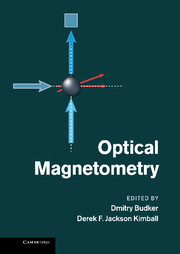Book contents
- Frontmatter
- Contents
- List of contributors
- Preface
- Part I Principles and techniques
- 1 General principles and characteristics of optical magnetometers
- 2 Quantum noise in atomic magnetometers
- 3 Quantum noise, squeezing, and entanglement in radiofrequency optical magnetometers
- 4 Mx and Mz magnetometers
- 5 Spin-exchange-relaxation-free (SERF) magnetometers
- 6 Optical magnetometry with modulated light
- 7 Microfabricated atomic magnetometers
- 8 Optical magnetometry with nitrogen-vacancy centers in diamond
- 9 Magnetometry with cold atoms
- 10 Helium magnetometers
- 11 Surface coatings for atomic magnetometry
- 12 Magnetic shielding
- Part II Applications
- Part III Broader impact
- Index
9 - Magnetometry with cold atoms
from Part I - Principles and techniques
Published online by Cambridge University Press: 05 May 2013
- Frontmatter
- Contents
- List of contributors
- Preface
- Part I Principles and techniques
- 1 General principles and characteristics of optical magnetometers
- 2 Quantum noise in atomic magnetometers
- 3 Quantum noise, squeezing, and entanglement in radiofrequency optical magnetometers
- 4 Mx and Mz magnetometers
- 5 Spin-exchange-relaxation-free (SERF) magnetometers
- 6 Optical magnetometry with modulated light
- 7 Microfabricated atomic magnetometers
- 8 Optical magnetometry with nitrogen-vacancy centers in diamond
- 9 Magnetometry with cold atoms
- 10 Helium magnetometers
- 11 Surface coatings for atomic magnetometry
- 12 Magnetic shielding
- Part II Applications
- Part III Broader impact
- Index
Summary
Introduction
The rapid development in recent decades of techniques for producing, trapping, and manipulating cold atoms has, as a side-benefit, made possible new methods of atomic magnetometry. The properties of cold atoms, including long coherence times and excellent spatial localization, are often desirable for high-precision magnetic sensing and allow the techniques of atomic magnetometry to be extended to previously inaccessible regions of parameter space.
Specifically, the appeal of cold atoms for magnetometry lies in the demonstrated potential for high sensitivity at high spatial resolution. Magnetic-field measurements with atoms at finite temperature are generally characterized by motional averaging, in which atoms statistically sample a volume of space determined by the measurement time, the velocity distribution, and, if present, the confinement. For high-spatial-resolution magnetometry, atomic motion must be limited. The average displacement of atoms can be reduced by decreasing the measurement time, but a shorter measurement time is unappealing because it degrades the sensitivity of the measurement. Tighter confinement is an alternative means of reducing atomic motion, and is indeed attractive provided the confinement does not adversely affect the atomic spin coherence. The use of buffer gases in vapor-cell magnetometers is effectively a form of confinement, and indeed allows magnetometry with millimeter-scale spatial resolution. However, buffer gases are not entirely benign for atomic spins, having small but finite spin-destruction collisional cross-sections [1], whose effects would be increasingly deleterious at the high pressures necessary to achieve micrometer-scale resolution. A final alternative is to reduce the velocity spread by cooling the atomic ensemble; indeed, the use of cold atoms permits a significant reduction in motional averaging, and can be achieved with no loss (and potentially an increase) in spin-coherence time.
- Type
- Chapter
- Information
- Optical Magnetometry , pp. 167 - 189Publisher: Cambridge University PressPrint publication year: 2013
- 1
- Cited by



